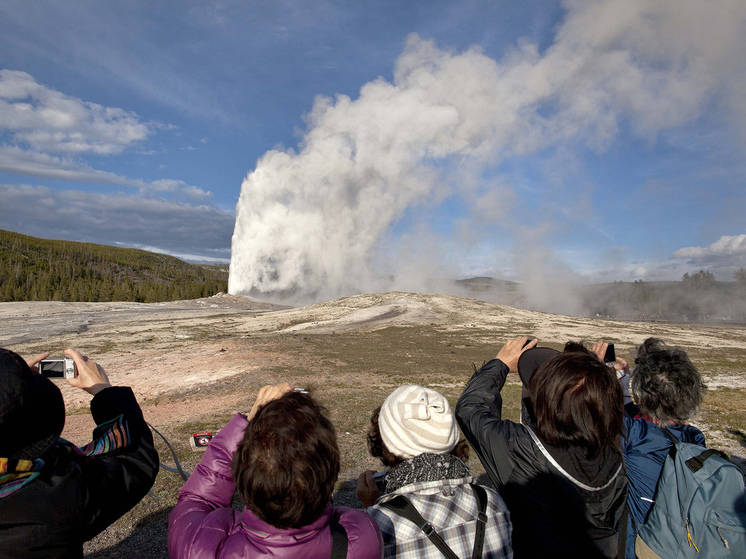Geologist explains technical aspects of possible event
Yellowstone supervolcano, or rather its possible eruption, has been scaring the world for years. It is believed that if Yellowstone wakes up, North America will definitely cease to exist. Scientists have tried to predict what might actually happen if Yellowstone decides to «play around.»

In late July, foreign media were abuzz with footage showing visitors to Yellowstone National Park forced to flee due to a sudden hydrothermal explosion. A mixture of dirt, rocks, and destroyed parts of paths built especially for tourists flew into the air.
Geologists considered the explosion in Biscuit Pool on July 23 to be a «normal event,» but the incident once again reminded us that sooner or later, the Yellowstone supervolcano, which has been dormant for 600,000 years, may awaken. And then a light fright will definitely not be enough.
Michael Poland, a research scientist at the Yellowstone Volcano Observatory, told the Daily Mail that if the park's 43-by-28-mile-wide volcano caldera blanketed the sky with volcanic ash, even parts of neighboring states would be in «bad shape.»
«The ash is heavy. It will cause problems with water, agriculture and the power grid,» the scientist said.
While the initial explosion of Yellowstone's caldera could kill thousands of people in a «supereruption,» such an event would not mean «the end of human history,» says Michael Polan.
Some suggest that the odds of a Yellowstone supereruption in any given year are now 700,000 to one. If one were to occur, several scenarios have been outlined for the aftermath.
If the supervolcano erupted in a single «big bang,» some suggest the blast could be equivalent to 875,000 megatons.
By comparison, the largest nuclear bomb ever made, the Soviet Tsar Bomba, had a yield of 50 megatons. That's just a few thousandths of a percent of the supervolcano's power.
Thousands of people are expected to die from the shock waves from the caldera's «big bang,» and much of the North American continent could be covered in up to a foot of ash.
Areas near the eruption will be devastated by scorching, destructive «pyroclastic flows» — a mixture of volcanic spatter containing lava, ash and pumice that is thrown into the air by rapidly expanding superheated gas.
The U.S. states that contain Yellowstone and surround the famous national park, including Montana, Idaho and Wyoming, will be hit.
But Poland added that new evidence suggests that Yellowstone's previous eruptions were not a single «big bang» but a series of eruptions.
But even in that scenario, a series of eruptions would still devastate an area within 125 miles of Yellowstone, Poland said. «There are plenty of examples of small amounts of ash causing buildings to collapse. There's a really amazing photo of an airplane in the Philippines after Mount Pinatubo erupted in 1991. The plane tilted up as it sat on the ground because the ash that fell on the back of it basically just flattened the tail.»
The geophysicist continued: Ash from these serial eruptions will cover fields, destroy power lines and collapse buildings, and deadly ash «drifts» will complicate the work of rescuers.
Areas closer to the eruption will be covered in more than three feet of ash, he said, including Salt Lake City, Utah, Boise, Idaho and Missoula, Montana.
The huge clouds of ash and sulfur created by the explosions will also lower global temperatures for years, if not decades, affecting agriculture in America and around the world.
As a well-documented example, Poland pointed to the 1816 eruption of Mount Tambora on the island of Sumbawa (now in Indonesia), which released a cloud of aerosols the size of Australia into the atmosphere: «In North America and Europe, this led to the so-called 'year without a summer' because global temperatures dropped for a year.»
The disaster caused crop failures in the United States and Europe due to the cold and lack of sunlight. Grain prices soared, and people in many countries went hungry.
Scientists have predicted that a Yellowstone supereruption would have a huge economic impact as rescuers struggle to clear away ash and restore power and water supplies. Scientists cite the relatively recent eruption of Iceland's Eyjafjallajökull volcano as an example.
According to Poland, the popular myth that a Yellowstone super-eruption would doom Earth to mass extinction will not happen: “No explosive eruption has ever led to the extinction of plants and animals, to a large-scale mass extinction. They devastate the region. They cool the climate. Then everything goes back to normal. I'm not saying it will be easy or fun to survive, but these are not the kinds of events that will wipe out life on planet Earth.”


